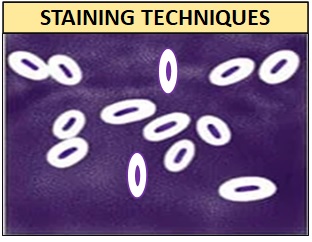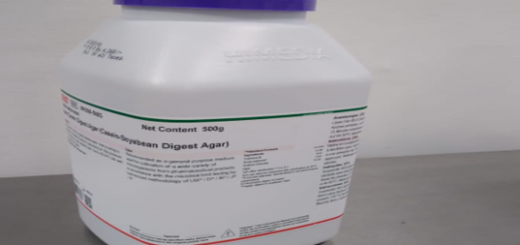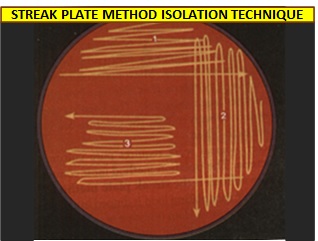Staining Techniques – A Comprehensive Guide

This article contains, detailed information on Stains and staining Techniques in Microbiology, including its importance, types of stains, and staining techniques and its Limitations.

Staining Techniques
What is mean by Staining Technique in Microbiology ?
Staining is an essential technique used in microbiology to identify and differentiate microorganisms based on their cellular and structural components. This Technique involves applying a colored dye or stain to the sample, which binds to specific components of the cell, making them visible under a microscope.
Importance of Staining Technique in Microbiology ?
Staining plays a crucial role in microbiology as it allows, microbiologist to visualize and identify microorganisms that are not visible to the naked eye. By staining different components of a microbe, such as the cell wall, cytoplasm, or nucleus, microbiologist can differentiate one microbe from another and can reveal important characteristics about microorganisms, such as their cell shape, size, and arrangement, as well as the presence of specific structure, Function and molecules.
What is mean by Stain?
Stains are chemical agents that are used to color microorganisms for microscopic examination. The ability of a stain to bind to microorganisms is due to the presence of chromophores and auxochromes.
Chromophore :
A chromophore is a chemical group that gives a stain its color. It is usually a conjugated system of double bonds that absorbs certain wavelengths of light and reflects others, producing a characteristic color. Examples of chromophores in microbiology stains include azo groups, carbonyl groups, and nitro groups.
Auxochrome :
An auxochrome is a chemical group that enhances the ability of a stain to bind to microorganisms. It is usually a charged or polar group that interacts with the bacterial cell surface, allowing the stain to bind more tightly. Examples of auxochromes in microbiology stains include amino groups, sulfonic acid groups, and carboxyl groups.
The combination of chromophores and auxochromes in a stain determines its color, as well as its ability to bind to different types of microorganisms. Different stains have different affinities for different types of bacteria, based on their cell wall composition, lipid content, or other properties.
Types of Stains :
There are various types of stains used in microbiology, Some of those are described as below :
Simple Stains :
Simple stains are the most basic type of stain used in microbiology. They use a single dye to color the entire microbe, making it easier to visualize under a microscope. Examples of simple stains include methylene blue, crystal violet, and safranin.
Simple stains are also known as monochrome stains, These dyes have a positive charge, which allows them to bind to the negatively charged bacterial cell wall, resulting in the staining of the cells.
Differential Stains
Differential stains are used to differentiate between different types of microorganisms based on their cellular components. There are various types of differential stains, includes,
- Gram Stain: This is the most commonly used differential stain in microbiology, and it differentiates between Gram-positive and Gram-negative bacteria based on the thickness of their cell walls.
- Acid-fast Stain: This stain is used to identify bacteria that have a waxy cell wall, such as Mycobacterium tuberculosis.
Special Stains :
Special stains are a type of staining technique used in microbiology to highlight specific components of a microbe that cannot be visualized using simple or differential staining techniques. These stains target specific cellular structures or components, such as flagella or capsules, and help researchers to gain a better understanding of the morphology and structure of microorganisms.
Some examples of special stains include:
Capsule Stain: Capsule staining is a special staining technique used to identify the presence of capsules around the bacterial cells. Capsules are gelatinous protective structures that help bacteria to evade the host’s immune system. The capsule stain involves using two different stains: India ink, which stains the background, and crystal violet, which stains the cells.
Flagella Stain: Flagella are whip-like structures that enable bacteria to move around. Flagella staining is a special staining technique used to visualize the presence and arrangement of flagella. This technique involves using a mordant, such as tannic acid, to fix the flagella to the cell, followed by staining with a dye such as carbolfuchsin.
Spirochete Stain: Spirochetes are a type of bacteria that have a unique spiral shape. Spirochete staining is a special staining technique used to visualize the spiral shape of these bacteria. This technique involves using a combination of dyes, such as crystal violet, carbolfuchsin, and methylene blue, to stain the cells.
Staining Techniques :
There are several staining Techniques used in microbiology, Some of those enlisted as below :
Simple Staining/Monochrome Staining Technique :
Simple staining involves using a single dye to color the entire microbe. To perform a simple stain, the sample is first fixed to a slide using a fixative, such as heat or alcohol. The dye is then applied to the sample, and the excess dye is washed off. The sample is then observed under a microscope.
Differential Staining Technique :
Gram Staining Technique :
Gram staining is a differential staining technique used to differentiate between Gram-positive and Gram-negative bacteria. The technique involves four steps:
- Applying crystal violet to the sample.
- Adding iodine to the sample to fix the dye.
- Decolorizing the sample with alcohol.
- Counterstaining the sample with safranin.
Gram-positive bacteria will appear purple under the microscope, while Gram-negative bacteria will appear pink.
Acid-Fast Staining Technique :
Acid-fast staining is used to identify bacteria that have a waxy cell wall, such as Mycobacterium tuberculosis. The technique involves three steps:
- Applying carbolfuchsin to the sample.
- Decolorizing the sample with acid-alcohol.
- Counterstaining the sample with methylene blue.
Acid-fast bacteria will appear red under the microscope, while non-acid-fast bacteria will appear blue.
Special Staining Technique :
- Capsule Staining Technique : This Technique uses two different stains to visualize bacterial capsules. A negative stain, such as India ink or nigrosin, is used to stain the background and the bacterial cells, leaving the capsule unstained. The slide is then counterstained with a basic stain, such as crystal violet or safranin, to stain the bacterial cells and visualize the unstained capsule.
- Flagella Staining Technique : This Technique uses a mordant, such as tannic acid or potassium alum, to coat the flagella of the bacterial cells, making them visible. The cells are then stained with a basic stain, such as safranin or crystal violet.
- Spirochete Staining Technique : is a special staining technique used to visualize spiral-shaped bacteria called spirochetes. The technique typically involves the use of a silver stain or a dark-field microscopy technique.
What are the advantages and limitations of staining Techniques?
Advantages : The advantages of staining techniques include the ability to visualize microorganisms and their structures, as well as the ability to identify and classify microorganisms.
Limitations : Can include potential inconsistencies due to improper staining or interpretation, as well as the inability to visualize certain types of microorganisms or structures.



